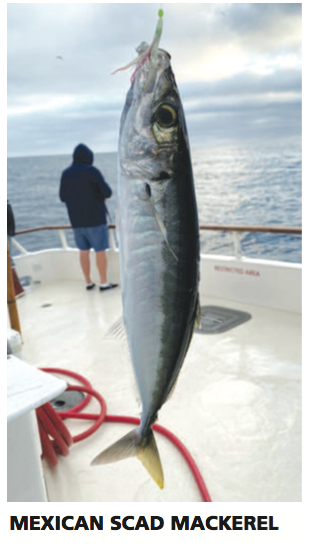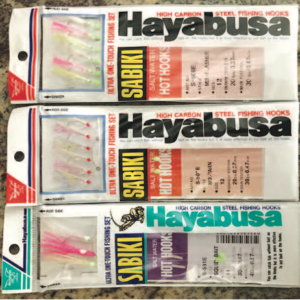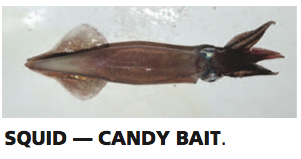Imagine being dead tired and sore from pulling on big yellowtail or tuna all day. You go to bed after a gourmet dinner only to be awoken at 3 a.m. to make (catch) bait. That is one of the necessary evils of long range fishing.
Making or catching bait is a huge and mandatory part of sportboat long range fishing. Tie on your Sabiki rigs well before evening time and be ready when the captain calls “all hands on deck” to make bait. Don’t be that guy who stays in his bunk while all the rest of us are catching bait. We will all know and call you names.

It could be fast and easy or it may be slow and tedious. It could begin right after dark, just before dawn, or at 2 a.m. when we get the call. It could take one hour or four hours. If there are 26 anglers on board, your captain and all your fellow anglers expect 26 anglers making bait. If the loud speakers are not working in your hallways or staterooms, make sure you ask somebody to wake you up so you don’t miss making bait. There are just a few medical excuses that may exempt you from this “fun” exercise (i.e. death). If you are healthy enough to take a fishing trip, you are healthy enough to make bait!
Bait may be the single most important factor for a successful long range fishing trip. Selecting a “hot” bait and presenting it perfectly separates the best anglers from the so-so anglers. Having a load of great sardines in your bait wells will certainly increase your odds of a good trip. Watch the time and care the captain and crew take in selecting and loading bait from the bait barges to th
e bait wells. Consider the huge amount of chum we cast overboard hoping to attract gamefish to the boat and get them into a feeding mode. Hear the crew members constantly telling you to get a fresh bait on your hook. And finally, appreciate the huge cost of bait; it is among the highest cost components of a long range fishing trip. The cost for bait varies per trip, running between 7.5% – 12% of passenger revenue. The bait for our recent 10-day trip cost over $8,000!
 I’m always impressed how long we spend at the bait barge to load our bait for a long range trip. It could take a couple hours for the crew to meticulously load hundreds and hundreds of scoops of bait. The Intrepid, for example, holds 800 scoops of bait. Observe how often the captain, chief engineer or crew members are checking the health of the bait in our bait wells. They scoop out and discard the dead bait at the bottom to avoid any diseases that may develop from decaying bait. On the longer expeditions, they even feed the bait. They are always monitoring the filters and pumps. Healthy bait and plenty of it is absolutely critical to having success.
I’m always impressed how long we spend at the bait barge to load our bait for a long range trip. It could take a couple hours for the crew to meticulously load hundreds and hundreds of scoops of bait. The Intrepid, for example, holds 800 scoops of bait. Observe how often the captain, chief engineer or crew members are checking the health of the bait in our bait wells. They scoop out and discard the dead bait at the bottom to avoid any diseases that may develop from decaying bait. On the longer expeditions, they even feed the bait. They are always monitoring the filters and pumps. Healthy bait and plenty of it is absolutely critical to having success.
So, we load tons of sardines and take them into fisheries where the gamefish have never seen a sardine. There are no sardines living at the Hurricane Bank, Clarion Island, Alijos Rocks, the Lower Banks or Guadalupe Island. Chumming sardines proves time after time that our targeted gamefish are opportunistic feeders and can easily be convinced to convert to a temporary sardine diet. But “matching the hatch” can often be vital to maximizing your opportunities as well, whether in trout fishing or tuna fishing.
Yellowtail and tuna in the southern zones are eating mackerel, so it makes sense to offer them a natural diet. So, we make bait. We catch mackerel.
Here are 20 tips for making bait on a long range trip:
1. Be sure to have several Sabiki rigs of different sizes on every long range fishing trip.
2. Be one of the first on deck after you hear the call to make bait. The crew will appreciate and respect it. So will your fellow anglers. They will also notice the guys who show up last, unprepared, or God forbid, choose to sleep in.
3. Be sure to put on the size Sabiki rig appropriate to the size mackerel you are targeting. The captain will announce the size (i.e. 2, 4 or 6 hook gangion). If you have any doubt, show your crew member your inventory and ask him to pick the best one.
4. You will likely make bait more than one night during your trip, so consider a dedicated setup.
5. The small mackerel are very delicate and the bite is very subtle, so an extra soft tip rod is extraordinarily helpful to detect when you have small mackerel hooked and to keep them on the hook. For small mackerel, you will use a 6-hook gangion, made with 25-pound line and tiny hooks.
6. Big, 1- and 2-pound mackerel warrant a heavier setup, a 2-hook gangion and 40-pound line.
 7. Spread out to avoid or minimize tangles – 25 anglers on a 90- by 25-foot boat can optimally have 8 feet between all anglers.
7. Spread out to avoid or minimize tangles – 25 anglers on a 90- by 25-foot boat can optimally have 8 feet between all anglers.
8. Communicate with your fellow anglers and the crew regarding the depth at which the bait is holding. When feeling the bait biting, start winding on one side of your reel, so when you drop next time your spool is “marked” at the proper depth.
9. Don’t poach or trespass. Respect the spots claimed by the anglers who started fishing for bait before you arrived. Move to some other available spot, which should then become yours.
10. Don’t drop between two people; you will cause a tangle!
11. Use the size weight suggested by your captain and crew. Weight will vary depending on current and wind, at anchor or drifting, respectively.
12. Use a reel with at least 50 yards of mono. This will make the inevitable tangles easier to resolve and less painful if the crew member has to cut off that much (expensive braided) line to get you back in business.
13. Wind your swivel all the way up to the top guide on your rod, grab the weight tightly and walk back to the crew member waiting for you at the bait tank.
14. If you have two or more baits on your Sabiki rig, hold the bottom one, closest to you, over the bait well for the crew member to release. Then back up to the next bait, and so on, until all the baits have been released into the bait well.
15. Watch the tip of your rod so you don’t poke a crew member in the face or entangle another angler.
16. Wait your turn at the bait well. When the bait is biting really well, there will be a line.
17. Baits will fall off. Just kick them over the side. Do not pick them up and take them to the bait tank.
18. When finished with baitmaking, stow your rod safely in the least trafficked areas, at the front of the boat or upstairs. The hooks are very sharp and it is not fun when you are responsible for burying a hook in the arm or face of a fellow angler, deckhand or yourself.
19. Make it fun. Bait making is critically important, inevitable and mandatory. Make it a game. Form competitions. Laugh a lot.
20. If you don’t help catch bait, don’t use any bait. Use only artificial jigs and lures. It’s the right thing to do if you don’t participate.

I hear guys talk about their favorite bait. My favorite bait is the one the fish want to eat at the exact hour and day I have my line in the water. You may labor for hours to make mackerel and the fish prefer your sardines. Of course, white seabass are general- ly gaga over squid. My 325-pound super cow came on a “tube sardine.” A lot of guys will always prefer jigs to bait, as will I if the fish are eating them. Many of the cow yellowfin come on chunks or large skipjacks, aka “man baits.”
The best anglers will quickly figure out what is working best, given what baits are available. And your crew members will always be the best resource if you are unsure which baits in the tank you should use.
Bottom line, making bait is critical and highly necessary to success in any West Coast saltwater fishing endeavors. Make it fun.




